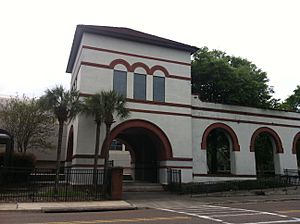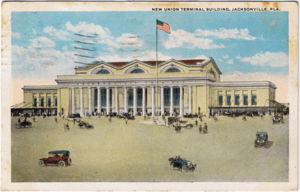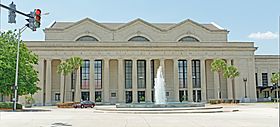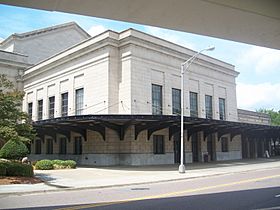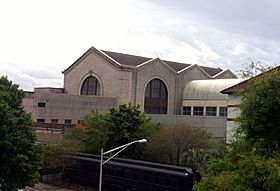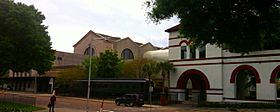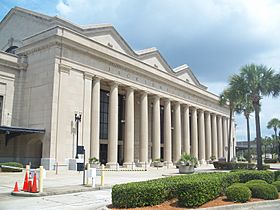Prime F. Osborn III Convention Center facts for kids
Quick facts for kids Prime F. Osborn III Convention Center |
|
|---|---|
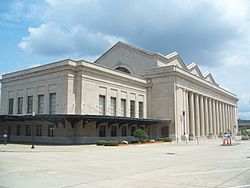 |
|
| Address | 1000 Water Street |
| Location | Jacksonville, Florida |
| Coordinates | 30°19′40″N 81°40′17″W / 30.32788°N 81.6713°W |
| Owner | City of Jacksonville |
| Built | 1919 |
| Opened | October 17, 1986 |
|
Former names
|
Union Station |
| Enclosed space | |
| • Total space | 265,000 sq ft (24,600 m2) |
| • Exhibit hall floor | 78,500 sq ft (7,290 m2) |
| Public transit access | Monorail: Convention Center station Northbank Line
|
| Website | |
| jaxevents.com | |
|
Jacksonville Terminal Complex
|
|
| Lua error in Module:Location_map at line 420: attempt to index field 'wikibase' (a nil value). | |
| Location | Jacksonville, Florida |
| Architect | Murchison, Kenneth M., Howe, W.B.W. |
| Architectural style | Beaux-Arts |
| NRHP reference No. | 76000590 |
| Added to NRHP | 1976 |
The Prime F. Osborn III Convention Center is a huge building in downtown Jacksonville, Florida. It covers about 265,000-square-foot (24,600 m2) of space. This center is a popular spot for big meetings, trade shows, and other events. It opened in 1986. What makes it special is that it was built using parts of an old, famous train station called the Jacksonville Terminal Complex or Union Station.
The convention center is located in the LaVilla neighborhood of Jacksonville. It has two large halls for exhibits, which together are about 78,500 square feet (7,290 m2). There are also many ballrooms and meeting rooms. The City of Jacksonville plans to build an even bigger convention center in the future. You can easily reach the Prime Osborn Convention Center by taking the JTA Skyway to its Convention Center station.
Contents
History of the Convention Center
The LaVilla area, which was once a suburb of Jacksonville, was very important for railroads. The first main train station in this area was built in 1883. It was used by several different railroad companies.
Building the First Union Depot
In 1894, a company was started by Henry Flagler. He owned the Florida East Coast Railway. The first big train station, called the Union Depot, opened on February 4, 1895. It was finished by January 15, 1897. People often called it the Flagler Depot. Five different railroad companies shared ownership of this station.
The Grand New Union Station
A second, even bigger Union Station opened in 1919. It was built right where the first one stood. This new station became the largest railroad station in the entire Southern United States.
At its busiest, the station handled up to 142 trains and 20,000 passengers every single day! Some of the passenger trains were very long, with 18 to 22 railcars. Inside the terminal, there were many shops and services. You could find a restaurant, snack bars, news stands, a barber shop, a florist, a drug store, and gift shops. The Jacksonville terminal had 32 tracks for trains. Twenty-nine of these tracks had platforms for passengers to get on and off. Some of the tracks were "stub" tracks, meaning they ended at decorative concrete posts. You can still see some of these posts inside the Convention Center today.
From Train Station to Convention Center
The train station was last used on January 3, 1974. After that, Amtrak (the national passenger rail service) moved to a new, smaller station in Jacksonville.
In 1982, a plan was started to turn the old station into something new. This project was led by a man named Prime F. Osborn III, who was a chairman of a big railroad company called CSX. Thanks to this effort, the new convention center opened its doors on October 17, 1986. It was named after Prime F. Osborn III.
Future Transportation Plans
There are exciting plans for new train services that could connect to the convention center area.
First Coast Commuter Rail
The First Coast Commuter Rail is a proposed train system for people who travel to work or school every day. It would serve Jacksonville and the surrounding areas in Northeast Florida. Planners are looking at routes that could go north to Yulee, southwest to Green Cove Springs, and southeast to St. Augustine.
Brightline High-Speed Rail
Brightline is a fast train system that connects cities. It currently runs between Miami, Florida and West Palm Beach, Florida. An extension is being built to Orlando, Florida. Jacksonville is a likely future stop for Brightline. This is because the FEC Railway already owns the train tracks that run to Jacksonville.
Gallery
Images for kids


